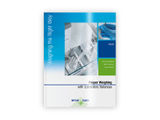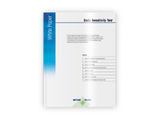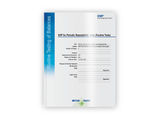To use all functions of this page, please activate cookies in your browser.
my.bionity.com
With an accout for my.bionity.com you can always see everything at a glance – and you can configure your own website and individual newsletter.
- My watch list
- My saved searches
- My saved topics
- My newsletter
CarrageenanCarrageenans or carrageenins (pronounced /ˌkærəˈgiːnənz/) are a family of linear sulphated polysaccharides extracted from red seaweeds. The name is derived from a type of seaweed that is abundant along the Irish coastline. Gelatinous extracts of the Chondrus crispus seaweed have been used as food additives for hundreds of years,[1] though analysis of carrageenan safety as an additive continues [2] Additional recommended knowledge
PropertiesCarrageenans are large, highly flexible molecules which curl forming helical structures. This gives them the ability to form a variety of different gels at room temperature, in the presence of some cations like potassium. They are widely used in the food and other industries as thickening and stabilizing agents. A particular advantage is that they are pseudoplastic — they thin under shear stress and recover their viscosity once the stress is removed. This means that they are easy to pump but stiffen again afterwards. There are three main commercial classes of carrageenan:
Many red algal species produce different types of carrageenans during their developmental history. For instance, the genera Gigartina produces mainly Kappa carrageenans during its gametophytic stage, and Lambda carrageenans during its sporophytic stage. See Alternation of generations. All are soluble in hot water, but in cold water only the Lambda form (and the sodium salts of the other two) are soluble. When used in food products, carrageenan has the EU additive E-number E407 or E407a when present as "Processed eucheuma seaweed". Although introduced on an industrial scale in the 1930s, the first use was in China around 600 BC (where Gigartina was used) and in Ireland around 400 AD. The largest producer is the Philippines, where cultivated seaweed produces about 80% of the world supply. The most commonly used are Cottonii (Kappaphycus alvarezii, K.striatum) and Spinosum (Eucheuma denticulatum), which together provide about three quarters of the World production. These grow at sea level down to about 2 metres. The seaweed is normally grown on nylon lines strung between bamboo floats and harvested after three months or so when each plant weighs around 1 kg. The Cottonii variety has been reclassified as Kappaphycus cottonii by Maxwell Doty (1988), thereby introducing the genus Kappaphycus, on the basis of the phycocolloids produced (namely kappa carrageenan). After harvest, the seaweed is dried, baled, and sent to the carrageenan manufacturer. There the seaweed is ground, sifted to remove impurities such as sand, and washed thoroughly. After treatment with hot alkali solution (e.g. 5-8% potassium hydroxide), the cellulose is removed from the carrageenan by centrifugation and filtration. The resulting carrageenan solution is then concentrated by evaporation. It is dried and ground to specification. Uses
Sexual lubricant and microbicideThere are indications that a carrageenan-based gel may offer some protection against HSV-2 transmission by binding to the receptors on the herpes virus thus preventing the virus from binding to cells. Researchers have shown that a carrageenan-based gel effectively prevented HSV-2 infection at a rate of 85% in a mouse model. See Herpes simplex: Polysaccharides A clinical trial by Population Council examining whether a carrageenan-based product known as Carraguard is effective as a topical microbicide for blocking HIV infection in women was completed in March 2007. Results are expected in early 2008.[3] A study published in August 2006 found it potentially a thousand times as effective against HPV (measuring in vitro infectivity of pseudoviruses, which are believed to mimic the activity of actual viruses). If effective, its cost compared to HPV vaccines and its ability to target any strain of the virus would make it an attractive prevention measure against cervical cancer, especially in developing countries.[3] Some personal and condom lubricants are already made with carrageenan, and several of these products (such as Bioglide and Divine) were found to be potent HPV inhibitors in the study (though others that listed carrageenan in their ingredients were not).[4] Although the researchers are optimistic and show that the products "block HPV infectivity in vitro, even when diluted a million-fold", they emphasize that "it would be inappropriate to recommend currently available products for use as topical microbicides" until further human tests are complete. (By comparison, similarly optimistic results were expected for HIV prevention by cellulose sulfate gels, based on early tests, but the clinical trials had to be halted when the gel was found to increase incidence of HIV infection.)[5] The researchers then tested HPV infectivity in mice. This study, released in July 2007, also found promising results, preventing infection in vivo by HPV-16 pseudoviruses even in the presence of nonoxynol-9, which was shown to greatly increase infection when used alone.[6] The results for the carrageenan tests (including those with Divine and Bioglide commercial lubricants) showed no detectable infection, while the viscous control gel and N-9 gels did.[7][8] While effectiveness trials have not been completed and side effects have not been ruled out, companies are already planning to capitalize on the discovery, such as Dreamspan naming their lubricant Carrageenan after its principal ingredient.[9][10][11] Health concernsThere is evidence from studies performed on rats, guinea pigs and monkeys which indicates that degraded carrageenan (poligeenan) may cause ulcerations in the gastro-intestinal tract and gastro-intestinal cancer.[12] Poligeenan is produced from carrageenan subjected to high temperatures and acidity. The average carrageenan molecule weighs over 100,000 Da while poligeenans have a molecular weight of less than 50,000 Da. A scientific committee working on behalf of the European Commission has recommended that the amount of degraded carrageenan be limited to a maximum of 5% (which is the limit of detection) of total carrageenan mass. Upon testing samples of foods containing high molecular weight carrageens, researchers found no poligeenan.[13] A recent publication[14] indicates that carrageenan induces inflammation in human intestinal epithelial cells in tissue culture through a Bcl10-mediated pathway that leads to activation of NFkappaB and IL-8. Carrageenan may be immunogenic due to its unusual alpha-1,3-galactosidic link that is part of its disaccharide unit structure. Consumption of carrageenan may have a role in intestinal inflammation and possibly inflammatory bowel disease, since Bcl10 resembles NOD2, mutations of which are associated with genetic proclivity to Crohn's Disease. See also
References
Look up carrageenan in Wiktionary, the free dictionary.
Categories: Polysaccharides | IARC Group 2B carcinogens |
|
| This article is licensed under the GNU Free Documentation License. It uses material from the Wikipedia article "Carrageenan". A list of authors is available in Wikipedia. |







